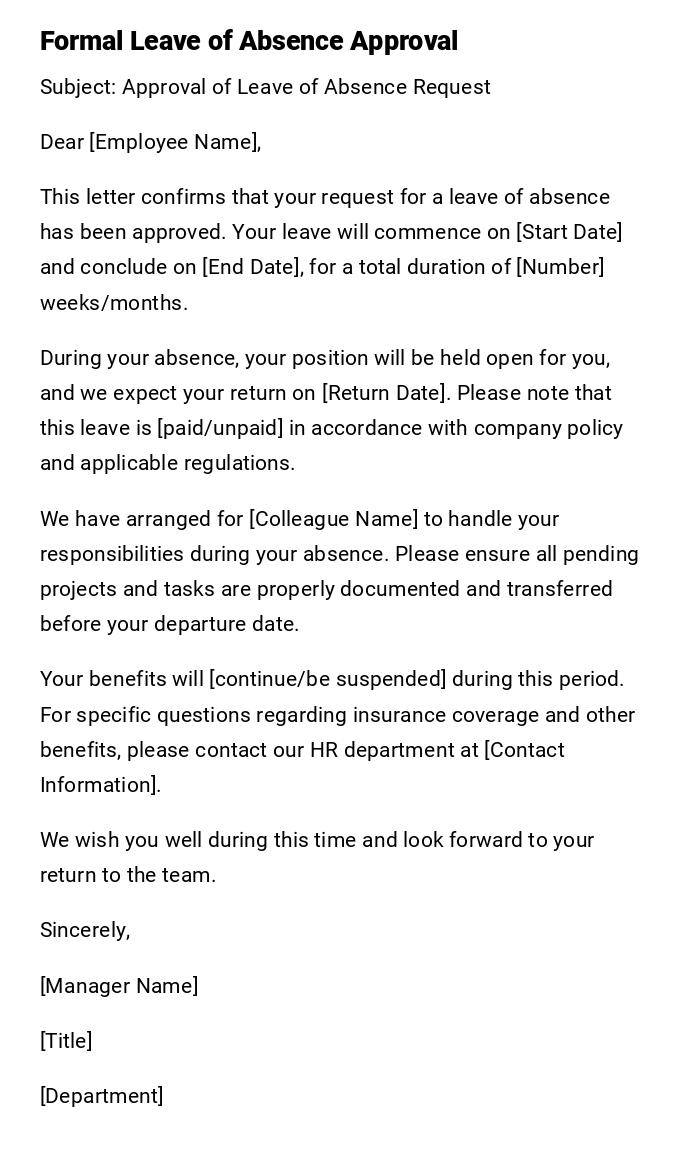Leave Of Absence Letter To Employee
Dear [Employee's Name],
I am writing this letter to discuss your request for a leave of absence from your position at [Company Name]. We understand that there are circumstances in life that may require time away from work, and we are committed to supporting our employees in maintaining a healthy work-life balance.
After reviewing your request, we are pleased to inform you that your request for a leave of absence has been approved. Your leave will commence on [start date] and is expected to last until [end date]. During this period, you will be entitled to [number of days/weeks] of paid/unpaid leave, as per company policy.
Please be aware that while you are on leave, you will not be required to perform any work-related tasks or responsibilities. We strongly encourage you to use this time to focus on your personal well-being and attend to any personal matters that require your attention.
It is important for you to understand the terms and conditions associated with your leave of absence. During your absence, you are expected to:
1. Notify the company promptly of any changes in your leave dates or circumstances.
2. Maintain open lines of communication with your supervisor or the HR department.
3. Provide any necessary documentation or updates as requested by the company.
4. Adhere to any relevant company policies regarding leave of absence.
If there are any changes to your circumstances or if you need to extend your leave, please notify us as soon as possible, preferably with at least [number of days/weeks] notice. We will do our best to accommodate any reasonable requests.
Please note that your benefits, such as health insurance coverage and retirement contributions, will continue during your leave of absence as per company policy. If there are any specific concerns or questions regarding your benefits, please contact our HR department for further assistance.
We value your contribution to [Company Name] and look forward to your return after your leave of absence. We believe that taking this time off will allow you to recharge and come back to work with renewed energy and focus.
If you have any questions or need further clarification regarding your leave, please do not hesitate to contact me or the HR department. We are here to assist you throughout this process.
Thank you for your understanding and cooperation. We wish you a productive and restful leave of absence.
Sincerely,
[Your Name]
[Your Position]
[Company Name]
Formal Leave of Absence Approval Letter
Subject: Approval of Leave of Absence Request
Dear [Employee Name],
This letter confirms that your request for a leave of absence has been approved. Your leave will commence on [Start Date] and conclude on [End Date], for a total duration of [Number] weeks/months.
During your absence, your position will be held open for you, and we expect your return on [Return Date]. Please note that this leave is [paid/unpaid] in accordance with company policy and applicable regulations.
We have arranged for [Colleague Name] to handle your responsibilities during your absence. Please ensure all pending projects and tasks are properly documented and transferred before your departure date.
Your benefits will [continue/be suspended] during this period. For specific questions regarding insurance coverage and other benefits, please contact our HR department at [Contact Information].
We wish you well during this time and look forward to your return to the team.
Sincerely,
[Manager Name]
[Title]
[Department]
Medical Leave of Absence Approval Letter
Subject: Medical Leave of Absence Approved
Dear [Employee Name],
We have received and reviewed your medical leave of absence request submitted on [Date]. Based on the medical documentation provided, your leave has been approved under [FMLA/Company Medical Leave Policy].
Your medical leave will begin on [Start Date] and is approved for [Duration]. This leave qualifies as job-protected leave, and your position will remain available upon your return.
During your medical leave, your health insurance benefits will continue with the same coverage. You are responsible for your portion of the premium payments, which can be arranged through [Payment Method].
Please keep HR informed of your recovery progress and provide medical clearance from your healthcare provider before returning to work. If you require an extension, submit a request along with updated medical documentation at least [Number] days before your scheduled return date.
We support you during this time and hope for your swift recovery.
Best regards,
[HR Manager Name]
[Human Resources Department]
Family Emergency Leave Approval Email
Subject: Immediate Leave of Absence Approved
Dear [Employee Name],
We understand that you are facing a family emergency and need to take immediate leave. Your request for emergency leave has been approved effective immediately.
You are approved for leave from [Start Date] through [Estimated End Date]. We recognize that the situation may be unpredictable, and we remain flexible regarding your return date. Please keep us updated on your circumstances as you are able.
Your position is secure, and we will work with you to ensure a smooth transition back to work when you are ready. In the meantime, [Colleague Name] will cover your urgent responsibilities.
Please don't hesitate to reach out if you need any support or have questions about your benefits during this difficult time.
Take care,
[Manager Name]
[Department]
Parental Leave Approval Letter
Subject: Parental Leave of Absence Approved
Dear [Employee Name],
Congratulations on your growing family! We are pleased to approve your parental leave request in accordance with our company policy and [FMLA/applicable law].
Your parental leave will begin on [Start Date] and extend through [End Date], providing you with [Number] weeks of leave. This includes [Number] weeks of paid leave followed by [Number] weeks of unpaid leave.
Your health benefits will continue throughout your leave period. Additional information about benefit continuation and premium payments has been sent separately by our benefits administrator.
We have created a transition plan for your responsibilities during your absence. Please coordinate with [Colleague Name] to ensure a smooth handover before your leave begins.
As your return date approaches, please contact HR to discuss any flexible work arrangements you may need during your transition back to work.
We wish you and your family all the best during this special time.
Warm regards,
[HR Manager Name]
[Human Resources Department]
Educational Leave Approval Letter
Subject: Approval for Educational Leave of Absence
Dear [Employee Name],
We are pleased to approve your request for an educational leave of absence to pursue [Degree/Certification/Program Name] at [Institution Name].
Your leave will be effective from [Start Date] to [End Date]. We believe this educational opportunity will enhance your professional skills and contribute to your career development within our organization.
Please note that this leave is unpaid, though you may use any accrued vacation time if you wish. Your position will be held for you during this period, and we expect your return on [Return Date].
Upon completion of your program, we ask that you share relevant knowledge or skills gained with your team. We also require a commitment to remain with the company for [Number] months following your return, as outlined in the educational leave agreement.
Please maintain contact with your supervisor periodically during your leave and notify us immediately if there are any changes to your expected return date.
We support your professional growth and look forward to your continued contributions to our team.
Best wishes,
[Manager Name]
[Title]
Personal Leave Denial with Alternative Options
Subject: Leave of Absence Request - Alternative Solutions
Dear [Employee Name],
Thank you for submitting your request for a personal leave of absence from [Start Date] to [End Date]. After careful consideration of operational needs and staffing requirements, we are unable to approve your request for the full duration as submitted.
However, we would like to work with you to find an alternative solution. We can offer the following options:
1. A modified leave period from [Alternative Dates] for [Shorter Duration]
2. A combination of vacation days and unpaid leave totaling [Number] weeks
3. A remote work arrangement for part of the requested period
4. A delayed leave start date of [Alternative Start Date]
We understand this may not fully meet your needs, but we are committed to finding a workable solution. Please schedule a meeting with me at your earliest convenience to discuss these alternatives and explore other possibilities.
Your contributions to the team are valued, and we want to support you while maintaining business continuity.
Please respond by [Date] with your preferred option or to arrange our discussion.
Sincerely,
[Manager Name]
[Title]
Military Leave Approval Letter
Subject: Military Leave of Absence Approved
Dear [Employee Name],
This letter confirms approval of your military leave of absence in compliance with the Uniformed Services Employment and Reemployment Rights Act (USERRA).
Your military leave will begin on [Start Date] for [Duration/Until Further Notice]. Your employment rights, seniority, and benefits are protected under federal law during your service period.
Health insurance coverage will continue for up to [Number] months at no cost to you. After that period, you may elect to continue coverage under COBRA provisions. Detailed information will be provided by our benefits department.
Upon completion of your military service, you have reemployment rights as specified under USERRA. Please notify us of your intent to return within the timeframe required by law, and provide any necessary military discharge documentation.
We are grateful for your service to our country and look forward to your safe return to our organization.
Respectfully,
[HR Director Name]
[Human Resources Department]
Sabbatical Leave Approval Letter
Subject: Sabbatical Leave Request Approved
Dear [Employee Name],
We are delighted to approve your sabbatical leave request. After [Number] years of dedicated service to our organization, you have earned this opportunity for personal and professional renewal.
Your sabbatical will begin on [Start Date] and conclude on [End Date], spanning [Duration] months. This leave is [partially paid/unpaid] as per our sabbatical policy.
During your sabbatical, we encourage you to pursue the activities you outlined in your application: [Brief Description]. We ask that you provide a brief report or presentation about your experience when you return, sharing insights that might benefit our organization.
Your benefits will continue during the sabbatical period, and your position will be waiting for you upon return. Please maintain periodic contact with HR and confirm your return date at least [Number] weeks in advance.
We look forward to welcoming you back with fresh perspectives and renewed energy.
Best regards,
[Executive/HR Director Name]
[Title]
What is a Leave of Absence Letter to an Employee
A leave of absence letter to an employee is an official document sent by an employer to formally respond to an employee's request for time away from work. This letter serves multiple purposes: it confirms whether the leave has been approved or denied, specifies the terms and conditions of the leave, outlines the duration and dates, clarifies the employee's status during the absence, and documents benefit continuation or suspension. The letter creates a legal record of the agreement between employer and employee, protecting both parties by clearly stating expectations, responsibilities, and rights during the leave period. It ensures compliance with labor laws and company policies while providing the employee with written confirmation they can reference throughout their absence.
Who Should Send a Leave of Absence Letter to an Employee
- Human Resources Department: Typically handles all leave-related correspondence for consistency and legal compliance
- Direct Manager or Supervisor: May send the letter for short-term or informal leaves in smaller organizations
- Department Head: Appropriate for leaves requiring higher-level approval
- HR Director or Manager: Sends letters for complex leave situations involving legal protections like FMLA
- Company Executive: May sign off on sabbaticals or extended leaves for senior employees
- Authorized Designee: Any person officially designated to handle leave administration in the employer's absence
When to Send a Leave of Absence Letter to an Employee
- After receiving a formal leave request: Once the employee submits their request through proper channels
- Following medical documentation review: When medical certificates or doctor's notes have been evaluated
- Upon management approval: After all necessary approvals from supervisors and HR have been obtained
- In response to emergency situations: Immediately when an employee needs urgent leave due to unforeseen circumstances
- Before the requested leave start date: Ideally with enough time for the employee to plan and arrange work transitions
- After legal compliance verification: Once HR confirms the leave meets FMLA, ADA, or other legal requirements
- When denying or modifying a request: Promptly to allow the employee to make alternative arrangements
- During annual leave planning: When approving scheduled leaves as part of organizational planning
- Following a leave extension request: When an employee asks to extend their existing leave period
Elements and Structure of a Leave of Absence Letter
- Subject Line: Clear reference to leave approval or denial
- Greeting: Professional salutation using the employee's name
- Opening Statement: Direct confirmation of the leave decision
- Leave Details: Specific start date, end date, and total duration
- Leave Type: Classification (medical, personal, parental, educational, etc.)
- Payment Status: Clear statement whether leave is paid, unpaid, or partially paid
- Job Protection: Assurance about position security or any changes
- Benefits Information: Status of health insurance, retirement contributions, and other benefits
- Coverage Arrangements: Information about who will handle the employee's responsibilities
- Return Expectations: Expected return date and any requirements for returning
- Contact Information: HR or manager contact details for questions
- Documentation Requirements: Any forms, certificates, or updates needed during leave
- Closing Statement: Supportive message appropriate to the situation
- Signature Block: Name, title, and department of the sender
- Attachments Reference: Mention of any accompanying documents or policies
How to Write and Send a Leave of Absence Letter to an Employee
- Review the leave request thoroughly: Examine all submitted documentation, forms, and supporting evidence
- Verify policy compliance: Check company handbook and applicable labor laws (FMLA, ADA, state regulations)
- Consult with stakeholders: Discuss with the employee's manager, HR team, and legal if necessary
- Make a clear decision: Determine whether to approve, deny, or offer modified terms
- Use official company letterhead: Maintain professional appearance and authenticity
- Be specific and concrete: Include exact dates, durations, and conditions without ambiguity
- State the legal basis: Reference applicable policies, laws, or collective bargaining agreements
- Address all key elements: Cover payment status, benefits, job protection, and return expectations
- Use appropriate tone: Professional yet compassionate, especially for medical or family leaves
- Proofread carefully: Ensure accuracy of dates, names, and all details
- Obtain necessary signatures: Have appropriate authority figures review and sign
- Send through reliable channels: Use certified mail, email with read receipt, or hand-delivery with acknowledgment
- Retain copies: Keep documentation in the employee's personnel file for legal and administrative purposes
- Follow up verbally: Consider a phone call or meeting for complex or sensitive situations
Requirements and Prerequisites Before Sending
- Written leave request from employee: Formal application through established company procedures
- Supporting documentation: Medical certificates, court documents, military orders, or other proof as applicable
- Manager recommendation: Input from the employee's direct supervisor about operational impact
- HR policy review: Verification that the request aligns with company leave policies
- Legal compliance check: Ensure adherence to FMLA, ADA, state laws, and union agreements
- Benefits department consultation: Clarification on insurance continuation and premium payments
- Staffing assessment: Evaluation of whether the department can accommodate the absence
- Budget approval: Confirmation that paid leave fits within departmental or organizational budget
- Coverage plan: Arrangement for who will handle the employee's duties during absence
- Previous leave history: Review of the employee's leave balance and prior absences
- Equal treatment verification: Ensure consistent application of policies across all employees
- Executive approval if needed: Higher-level sign-off for extended or unusual leave requests
Common Mistakes to Avoid When Writing Leave of Absence Letters
- Being vague about dates: Always provide specific start and end dates rather than approximate timeframes
- Omitting payment details: Failing to clearly state whether leave is paid, unpaid, or partially compensated
- Ignoring benefits information: Not addressing health insurance, retirement, and other benefit continuation
- Missing legal protections: Forgetting to reference FMLA, ADA, or other applicable legal protections
- Using inappropriate tone: Being too casual for serious situations or too cold for compassionate circumstances
- Incomplete job protection details: Not clarifying whether the position is guaranteed upon return
- Delayed sending: Waiting too long to respond, leaving the employee uncertain about their request
- Lack of documentation requirements: Not specifying what paperwork or updates are needed during leave
- Inconsistent policy application: Treating similar requests differently without justifiable reasons
- No contact information: Forgetting to provide HR or manager contact details for questions
- Ambiguous conditions: Using unclear language about expectations, restrictions, or requirements
- Missing signatures: Sending unsigned letters that lack official authorization
- Failing to address extensions: Not explaining the process if the employee needs more time
- Overlooking return procedures: Not outlining what steps are needed before returning to work
Formatting Guidelines for Leave of Absence Letters
- Length: Typically one to two pages; concise yet comprehensive
- Format: Business letter format on company letterhead
- Font: Professional fonts like Arial, Calibri, or Times New Roman in 11-12 point size
- Tone: Professional, clear, and appropriately compassionate based on leave type
- Structure: Organized paragraphs with logical flow from decision to details to closing
- Date format: Use consistent date formatting throughout (MM/DD/YYYY or spelled out)
- Spacing: Single-spaced paragraphs with double spacing between paragraphs
- Delivery method: Email for routine approvals, printed letter for formal or legal leaves, certified mail for denials
- Subject line: Direct and specific (e.g., "Leave of Absence Approval" not just "Your Request")
- Signature: Original signature for printed letters, electronic signature acceptable for emails
- Copies: Always CC or BCC human resources and maintain proper filing
- Language: Clear, direct language avoiding jargon or overly legal terminology
- Emphasis: Bold or underline key information like dates and requirements sparingly
- Attachments: Reference any accompanying documents like policy excerpts or forms
Follow-up Actions After Sending the Letter
- Confirm receipt: Follow up within 2-3 days to ensure the employee received the letter
- Schedule transition meeting: Arrange time for the employee to brief their temporary replacement
- Document in personnel file: Keep copies of the letter and all related correspondence
- Update HR systems: Record the leave in payroll, benefits, and attendance tracking systems
- Notify relevant parties: Inform payroll, benefits administrators, and team members as appropriate
- Set calendar reminders: Mark the return date and any interim check-in points
- Maintain periodic contact: Check in at appropriate intervals for extended leaves (monthly for long absences)
- Monitor documentation deadlines: Track when medical updates or other required documents are due
- Prepare for return: Begin planning reintegration 2-4 weeks before scheduled return date
- Address extension requests promptly: Respond quickly if the employee needs more time
- Update coverage arrangements: Make adjustments if the leave duration changes
- Conduct return-to-work meeting: Schedule discussion about transition back and any accommodations needed
- Review and update policies: Note any issues or improvements needed in leave procedures
Tips and Best Practices for Leave of Absence Letters
- Use templates but personalize: Start with standard templates but customize for each situation
- Be empathetic yet professional: Show understanding while maintaining business boundaries
- Respond promptly: Aim to respond within 3-5 business days of receiving the request
- Provide clear next steps: Tell the employee exactly what they need to do before leaving
- Include an FAQ sheet: Attach common questions and answers about leave policies
- Offer a contact person: Designate someone the employee can reach during their absence
- Set boundaries on communication: Clarify when and how the company will contact them during leave
- Document verbal agreements: Always follow up conversations with written confirmation
- Review with legal counsel: Have templates reviewed by employment lawyers annually
- Consider cultural sensitivity: Be aware of different cultural perspectives on family, health, and work
- Provide policy excerpts: Attach relevant sections of the employee handbook
- Use positive language: Frame information constructively, especially for denials or modifications
- Prepare managers: Brief supervisors on how to support employees before and after leave
- Track patterns: Monitor leave requests for workforce planning and policy effectiveness
Advantages and Disadvantages of Formal Leave Letters
Advantages:
- Creates clear legal documentation protecting both employer and employee
- Eliminates misunderstandings about leave terms and conditions
- Demonstrates compliance with labor laws and regulations
- Provides written reference for the employee throughout their absence
- Establishes professional boundaries and expectations
- Supports consistent policy application across the organization
- Creates records for payroll, benefits, and workforce planning
- Shows organizational support for employee wellbeing
Disadvantages:
- Can feel impersonal or bureaucratic for sensitive situations
- Requires administrative time and resources to prepare properly
- May create anxiety if language is overly formal or legalistic
- Can be misinterpreted if not carefully worded
- Might limit flexibility if circumstances change during leave
- Could expose company to liability if information is incorrect
- May seem excessive for short or simple leave requests
- Can create paper trail that complicates future employment decisions
Comparing Leave of Absence Letters with Alternative Approaches
Leave Letter vs. Verbal Approval:
- Letters provide legal documentation; verbal approvals leave room for disputes
- Written communication ensures all details are captured accurately
- Letters required for FMLA and other legally protected leaves
- Verbal may suffice for short, informal absences but risky for extended periods
Leave Letter vs. Email Confirmation:
- Formal letters carry more weight for serious or extended leaves
- Emails faster and adequate for routine or short-term leaves
- Letters on letterhead appear more official and authoritative
- Emails easier to track and store in digital systems
Leave Letter vs. Leave Management System:
- Digital systems provide automated tracking and compliance
- Letters offer personal touch and detailed customization
- Systems better for high-volume leave administration
- Letters necessary for complex situations requiring explanation
Leave Letter vs. Employment Contract Amendment:
- Amendments required when leave terms differ significantly from original agreement
- Letters sufficient for temporary absences within existing policy framework
- Contracts provide stronger legal protection for both parties
- Letters more flexible and quicker to execute
Frequently Asked Questions About Leave of Absence Letters
Must the letter specify whether the position is guaranteed upon return? Yes, job protection status must be clearly stated, especially for legally protected leaves where the position must be held.
How quickly should employers respond to leave requests? Typically within 3-5 business days for non-emergency requests; immediately for urgent situations requiring emergency leave.
Can an employer require periodic updates during leave? Yes, for medical leaves employers can require periodic recertification, but restrictions apply under FMLA regarding frequency and type.
What if the employee needs to extend their leave? The letter should outline the extension request process; employees typically must submit new documentation and receive new approval.
Should salary information be included in the letter? Specify whether leave is paid or unpaid, but detailed salary calculations are usually handled separately by payroll documentation.
Can terms be changed after the letter is sent? Modifications require written amendment with agreement from both parties; unilateral changes may violate employment law.
Is the employee required to sign and return the letter? While not always legally required, requesting signed acknowledgment provides proof the employee received and understood the terms.
How long should the company keep leave letters on file? Generally maintain in personnel files for at least 3-7 years, depending on state law and company policy.
Does a Leave of Absence Letter Require Authorization
Leave of absence letters typically require multiple levels of authorization depending on the organization's structure and the type of leave:
- Direct supervisor approval: Usually the first level, confirming operational feasibility
- HR department verification: Essential for ensuring policy compliance and legal protection
- Executive sign-off: Required for extended leaves, sabbaticals, or unusual circumstances
- Legal review: Necessary for complex situations involving potential liability
- Benefits administrator input: When leave affects insurance, retirement, or other benefits
- Union approval: In unionized workplaces, collective bargaining agreements may specify authorization requirements
- Board approval: Very long leaves or those with significant financial impact may require board authorization
The letter itself serves as written authorization to the employee, and should be signed by someone with authority to bind the company to the terms stated. This is typically an HR manager, director, or executive rather than just a supervisor. Keep authorization documentation in case disputes arise later about who approved what terms.










 Download Word Doc
Download Word Doc
 Download PDF
Download PDF